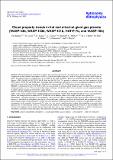Files in this item
Cloud property trends in hot and ultra-hot giant gas planets (WASP-43b, WASP-103b, WASP-121b, HAT-P-7b, and WASP-18b)
Item metadata
| dc.contributor.author | Helling, Ch. | |
| dc.contributor.author | Lewis, D. | |
| dc.contributor.author | Samra, D. | |
| dc.contributor.author | Carone, L. | |
| dc.contributor.author | Graham, V. | |
| dc.contributor.author | Herbort, O. | |
| dc.contributor.author | Chubb, K.L. | |
| dc.contributor.author | Min, M. | |
| dc.contributor.author | Waters, R. | |
| dc.contributor.author | Parmentier, V. | |
| dc.contributor.author | Mayne, N. | |
| dc.date.accessioned | 2021-05-26T14:30:11Z | |
| dc.date.available | 2021-05-26T14:30:11Z | |
| dc.date.issued | 2021-05-10 | |
| dc.identifier | 274371224 | |
| dc.identifier | 7fb878c8-58f9-4b71-a429-1943bbf92fdb | |
| dc.identifier | 85105800243 | |
| dc.identifier | 000655625900003 | |
| dc.identifier.citation | Helling , C , Lewis , D , Samra , D , Carone , L , Graham , V , Herbort , O , Chubb , K L , Min , M , Waters , R , Parmentier , V & Mayne , N 2021 , ' Cloud property trends in hot and ultra-hot giant gas planets (WASP-43b, WASP-103b, WASP-121b, HAT-P-7b, and WASP-18b) ' , Astronomy and Astrophysics , vol. 649 , A44 . https://doi.org/10.1051/0004-6361/202039911 | en |
| dc.identifier.issn | 0004-6361 | |
| dc.identifier.other | RIS: urn:4C390C63B8271070DC797F7DC102762D | |
| dc.identifier.other | ORCID: /0000-0002-1807-4441/work/94669905 | |
| dc.identifier.other | ORCID: /0000-0002-4552-4559/work/104252890 | |
| dc.identifier.uri | https://hdl.handle.net/10023/23255 | |
| dc.description | Ch.H. and M.M. acknowledge funding from the European Union H2020-MSCA-ITN-2019 under Grant Agreement no. 860470 (CHAMELEON). D.S. acknowledges financial support from the Science and Technology Facilities Council (STFC), UK. for his PhD studentship (project reference 2093954), and O.H. acknowledges the PhD stipend from the University of St Andrews’ Centre for Exoplanet Science. V.G. acknowledges the hospitality of the School of Physics & Astronomy at the University of St Andrews and the summer student funding from the Royal Astronomical Society. | en |
| dc.description.abstract | Context. Ultra-hot Jupiters are the hottest exoplanets that have been discovered so far. Observations begin to provide insight into the composition of their extended atmospheres and their chemical day/night asymmetries. Both are strongly affected by cloud formation. Aims. We explore trends in cloud properties for a sample of five giant gas planets: the hot gas giant WASP-43b and the four ultra-hot Jupiters (UHJs) WASP-18b, HAT-P-7b, WASP-103b, and WASP-121b. This provides a reference frame for cloud properties for the JWST targets WASP-43b and WASP-121b. We further explore chemically inert tracers to observe geometrical asymmetries of UHJs and if the location of the inner boundary of a 3D global circulation model (3D GCM) matters for the clouds that form. Methods. A homogeneous set of 3D GCM results was used as input for a kinetic cloud formation code to evaluate the cloud opacity and gas parameters such as C/O, mean molecular weight, and degree of ionisation. We cast our results in terms of integrated quantities to enable a global comparison between the sample planets. Results. The large day/night temperature differences of UHJs cause the following chemical asymmetries: cloud-free days but cloudy nights, atomic versus molecular gases and their different mean molecular weights, deep thermal ionospheres versus low-ionised atmospheres, and undepleted versus enhanced C/O. WASP-18b, as the heaviest planet in the sample, has the lowest global C/O. Conclusions. The global climate may be considered as similar amongst UHJs, but different to that of hot gas giants. The local weather, however, is individual for each planet since the local thermodynamic conditions, and hence the local cloud and gas properties, differ. The morning and the evening terminator of UHJs will carry signatures of their strong chemical asymmetry such that ingress and egress asymmetries can be expected. An increased C/O ratio is a clear sign of cloud formation, making cloud modelling a necessity when utilising C/O (or other mineral ratios) as a tracer for planet formation. The changing geometrical extension of the atmosphere from the day to the nightside may be probed through chemically inert species such as helium. Ultra-hot Jupiters are likely to develop deep atmospheric ionospheres which may impact the atmosphere dynamics through magneto-hydrodynamic processes. | |
| dc.format.extent | 34 | |
| dc.format.extent | 9574144 | |
| dc.language.iso | eng | |
| dc.relation.ispartof | Astronomy and Astrophysics | en |
| dc.subject | Astrochemistry | en |
| dc.subject | Planets and satellites: atmospheres | en |
| dc.subject | Planets and satellites: gaseous planets | en |
| dc.subject | Solid state: refractory | en |
| dc.subject | QB Astronomy | en |
| dc.subject | QC Physics | en |
| dc.subject | 3rd-DAS | en |
| dc.subject | SDG 13 - Climate Action | en |
| dc.subject.lcc | QB | en |
| dc.subject.lcc | QC | en |
| dc.title | Cloud property trends in hot and ultra-hot giant gas planets (WASP-43b, WASP-103b, WASP-121b, HAT-P-7b, and WASP-18b) | en |
| dc.type | Journal article | en |
| dc.contributor.sponsor | European Commission | en |
| dc.contributor.institution | University of St Andrews. St Andrews Centre for Exoplanet Science | en |
| dc.contributor.institution | University of St Andrews. School of Physics and Astronomy | en |
| dc.identifier.doi | 10.1051/0004-6361/202039911 | |
| dc.description.status | Peer reviewed | en |
| dc.identifier.grantnumber | 860470 | en |
This item appears in the following Collection(s)
Items in the St Andrews Research Repository are protected by copyright, with all rights reserved, unless otherwise indicated.

